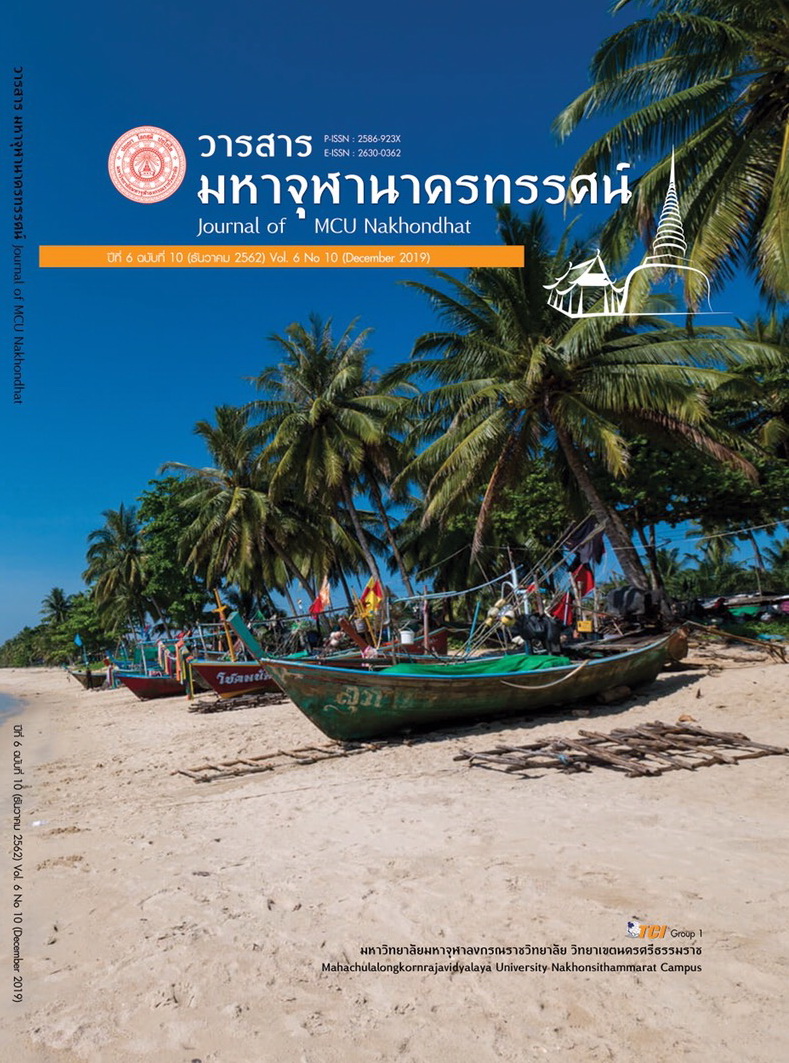QUALITY OF LIFE DEVELOPMENT OF THE ELDERLY AT LAMPANG PROVINCE
Main Article Content
Abstract
The objectives of the research were 1) to study the effectiveness level of developing the quality of life for the elderly at Lampang province, 2) to consider the factors affecting the quality of life development of the elderly with relation to the effectiveness of the quality of life development of the elderly at Lampang province, 3) to examine the factors that affect the effectiveness of the quality of life development of the elderly at Lampang province, and 4) to inspect the problems, obstacles, and needs of the elderly in order to improve the quality of life of the elderly at Lampang province. Methodology was the mixed methods rearch : The Quantitative research collected data from 400 samples of elderly persons living at Lampang province, with close ended questionnaires and analyzed data with social research analysis program with frequencies, percentiles, mean, standard deviation, Pearson’s correlation coefficient analysis and multiple regression analysis. The Qualitative research collected data from 20 key informants with structured-in-depth-interview scripts. Data were analyzed by descriptive interpretation.
Findings were as follows:
- The results showed that the effectiveness of the quality of life development of the elderly at Lampang province overall was at a high level. Opinions toward each aspect were also at high level; education of lifelong learning. Followed by health and hygiene for the elderly and promotion of employment and income security, respectively.
- The factors affecting the quality of life development of the elderly with relation to support from the elderly family a positive correlation at high level (r = .738) with a significance level of 0.01. Relationship on many levels the second factor support of the support from the local government organization at high level (r = .719) with a significance level of 0.01. The third factor is the support from the central government at correlated moderately (r = .515) with a significance level of 0.01. and the support from the community and society respectively at correlated low levels (r = .470) with a significance level of 0.01.
- The factors that affect the effectiveness of the quality of life development of the elderly at Lampang province, including with 4 factors : that support from the elderly family, the support from the local government organization, the support from the central government and the support from the community and society respectively at statistical significant level at .01. Predict the effectiveness of the quality of life of the elderly receive 72.70 percent.
- The support from the community and society respectively. As for the problems, obstacles, and needs of the elderly for effectiveness of the quality of life of the elderly at Lampang was early support for the elderly to work on their skills, improvement of public health policy, medical service, various facilities for the elderly and the elderly want to receive more premiums to improve their quality of life.
Article Details
References
กระทรวงพัฒนาสังคมและความมั่นคงของมนุษย์. (2558). กฎหมายผู้สูงอายุ. เรียกใช้เมื่อ 15 ตุลาคม 2559 จาก https://law.m-society.go.th.
ขวัญดาว กล่ำรัตน์. (2554). ปัจจัยเชิงสาเหตุของพฤติกรรมสุขภาพของผู้สูงอายุในเขตภูมิภาคตะวันตก. กรุงเทพมหานคร: มหาวิทยาลัยศิลปากร.
จรัญญา วงษ์พรหม. (2558). การมีส่วนร่วมของชุมชนเพื่อพัฒนาคุณภาพชีวิตผู้สูงอายุ. กรุงเทพมหานคร: มหาวิทยาลัยศิลปากร.
จังหวัดลำปาง. (2560). แผนพัฒนาจังหวัดลำปาง 4 ปี (2561 – 2564). เรียกใช้เมื่อ 15 ธันวาคม 2559 จาก https://www.lampang.go.th/index1.php
ชลธิชา สินสุพรรณ์. (2556). ความสัมพันธ์ระหว่างสัมพันธภาพในครอบครัวกับคุณภาพชีวิตของผู้สูงอายุในเขตตำบลเสาเดียว อำเภอหนองหงส์ จังหวัดบุรีรัมย์. บุรีรัมย์: โรงพยาบาลส่งเสริมสุขภาพตำบลเสาเดียว.
ธนยศ สุมาลย์โรจน์ และคณะ. (2558). ผู้สูงอายุในโลกแห่งการทำงาน มุมมองเชิงทฤษฎีทางกายจิตสังคม. วารสารปัญญาภิวัฒน์, 7(1), 242 - 254.
ปณิธี บราวน์. (2557). พฤฒพลัง: บทบาทของกลุ่มผู้สูงอายุและ “ทุน” ที่ใช้ในการขับเคลื่อนงานด้านผู้สูงวัย. วารสารคณะมนุษย์ศาสตร์และสังคมศาสตร์ มหาวิทยาลัยขอนแก่น, 31(3), 97 - 120.
พรทิพย์ มาลาธรรม และคณะ. (2552). ความสัมพันธ์ระหว่างแรงสนับสนุนจากครอบครัวและแรงสนับสนุนจากเพื่อกับความพึงพอใจในชีวิตของผู้สูงอายุในชนบท. รามาธิบดีพยาบาลสาร, 15(3), 431 - 448.
วรรณี วิริยะกังสานนท์. (2556). ปัจจัยที่มีผลต่อการคงอยู่ของพยาบาลวิชาชีพในโรงพยาบาลเอกชนแห่งหนึ่งในกรุงเทพมหานคร. นครปฐม: มหาวิทยาลัยคริสเตียน.
ศูนย์พัฒนาการจัดสวัสดิการสังคมผู้สูงอายุ จังหวัดลำปาง. (2559). ข้อมูลผู้สูงอายุในจังหวัดลำปาง. เรียกใช้เมื่อ 13 สิงหาคม 2559 จาก https://www.olderlampang.go.th.
สมศักดิ์ ชุณหรัศมิ์. (2559). ศักยภาพองค์กรปกครองส่วนท้องถิ่นกับการพัฒนาคุณภาพชีวิตผู้สูงอายุ. เรียกใช้เมื่อ 30 มกราคม 2560 จาก https://www.thaitgri.org.
สำนักงานเลขาธิการสภาการศึกษา. (2558). แผนการศึกษาแห่งชาติ ฉบับปรับปรุง พ.ศ. 2552 – 2559. เรียกใช้เมื่อ 10 กันยายน 2559 จาก https://www.onec.go.th.
อภิญญา ศิริพิทยาคุณกิจ. (2553). แรงสนับสนุนทางสังคม : ปัจจัยสำคัญในการดูแลผู้ที่เป็นเบาหวาน. รามาธิบดีพยาบาลสาร, 16(2), 309-323.
อาชัญญา รัตนอุบล และคณะ. (2554). การศึกษาและการเรียนรู้ตลอดชีวิตของผู้สูงอายุไทย มูลนิธิสถาบันวิจัยและพัฒนาผู้สูงอายุไทย (มส.ผส.) สถาบันวิจัยระบบสาธารณสุข (สวรส.). Retrieved 30 September 2559 จาก https://kb.hsri.or.th
Andrews, F.M. and Rick Crandall. (1976). The validity of measures of self-reported well-being. Social Indicator research : An International and Interdisciplinary. Journal for Quality-of-Life Measurement, 3(1), 1-19.
Beach, E.K., et al. (1992). The spouse : A factor in recovery after myocardial infarction. Ohio: University of Akron School of Nursing.
Campbell, A. et al. (1976). The Quality of American life. New York: Russel Sage Foundation.
Farquhar, M. (1995). Elderly people’s definitions of quality of life. Social science & medicine, 41(10), 1439-1446.
Likert, R. A. (1932). Technique for the Measurement of Attitude. Archives Psychological, 3(1), 42-48.
Maslow Abraham. (1943). A Theory of Human Motivation. Originally Published in Psychological Review, 50, 370-396.
Retrieved September 26 , 2559, from https://psychclassics.yorku.ca/Maslow/motivation.htm
Taro Yamane. (1973). Statistics: An Introductory Analysis.(3rd ed). New York: Harper and Row Publications.


